Transforming waste heat directly into electricity

BINE Themeninfo brochure entitled "Thermoelectrics: power from waste heat" © BINE Informationsdienst
Thermoelectric generators can utilise the smallest temperature differences
Thermoelectrics works in two directions: it can convert heat directly into electricity or, as a so-called Peltier element, use electrical power to generate cooling energy. Put simply, thermoelectric elements consist of two different conductive materials whose electrical contacts are located in different temperature ranges.
The difference between the two temperatures creates an electrical voltage and thus power. These days the elements are able to generate up to 1,000 watts.
New materials will be able to process larger temperature differences and thus generate even greater outputs. The major advantage of thermoelectric elements is that they work vibration-free, silently and with no moving parts. They therefore require relatively low maintenance and have long service lives.
Until now, thermoelectric elements have been particularly used in aerospace, for example in the Mars rover Curiosity, in energy-autonomous and maintenance-free sensors, for cooling electrical equipment and in silent hotel fridges and camping cool boxes. In future, the elements could play a greater role in the automotive industry, for example for supporting on-board power supplies and for utilising industrial waste heat.
For this BINE Themeninfo brochure, Dr. Jan König from the Fraunhofer Institute for Physical Measurement Techniques coordinated a group of writers working on this topic in German research institutes and companies.
You found all informations about the BINE info brochure “Thermoelectrics: power from waste heat” here:
http://www.bine.info/en/publications/publikation/thermoelektrik-strom-aus-abwaer…
Uwe Milles/Birgit Schneider
presse(at)bine.info
About BINE Information Service
Energy research for practical applications
The BINE Information Service reports on energy research topics, such as new materials, systems and components, as well as innovative concepts and methods. The knowledge gained is incorporated into the implementation of new technologies in practice, because first-rate information provides a basis for pioneering decisions, whether in the planning of energy-optimised buildings, increasing the efficiency of industrial processes, or integrating renewable energy sources into existing systems.
About FIZ Karlsruhe
FIZ Karlsruhe – Leibniz Institute for Information Infrastructure is a not-for-profit organization with the public mission to make sci-tech information from all over the world publicly available and to provide related services in order to support the national and international transfer of knowledge and the promotion of innovation.
Our business areas:
• STN International – the world’s leading online service for research and patent information in science and technology
• KnowEsis – innovative eScience solutions to support the process of research in all its stages, and throughout all scientific disciplines
• Databases and Information Services – Databases and science portals in mathematics, computer science, crystallography, chemistry, and energy technology
FIZ Karlsruhe is a member of the Leibniz Association (WGL) which consists of 87 German research and infrastructure institutions.
http://www.bine.info/en – BINE Informationsdienst
Media Contact
All latest news from the category: Power and Electrical Engineering
This topic covers issues related to energy generation, conversion, transportation and consumption and how the industry is addressing the challenge of energy efficiency in general.
innovations-report provides in-depth and informative reports and articles on subjects ranging from wind energy, fuel cell technology, solar energy, geothermal energy, petroleum, gas, nuclear engineering, alternative energy and energy efficiency to fusion, hydrogen and superconductor technologies.
Newest articles

First-of-its-kind study uses remote sensing to monitor plastic debris in rivers and lakes
Remote sensing creates a cost-effective solution to monitoring plastic pollution. A first-of-its-kind study from researchers at the University of Minnesota Twin Cities shows how remote sensing can help monitor and…

Laser-based artificial neuron mimics nerve cell functions at lightning speed
With a processing speed a billion times faster than nature, chip-based laser neuron could help advance AI tasks such as pattern recognition and sequence prediction. Researchers have developed a laser-based…

Optimising the processing of plastic waste
Just one look in the yellow bin reveals a colourful jumble of different types of plastic. However, the purer and more uniform plastic waste is, the easier it is to…



